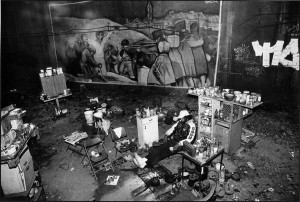In Irina Nersessova’s Tapestry of Space: Domestic Architecture and Underground Communities in Margaret Morton’s Photography of a Forgotten New York, she provides insight into Margaret Morton’s photographs of underground and aboveground homes of the homeless in New York City. In Morton’s The Tunnel, she shows how the homeless living in the underground tunnels of New York survive and live through her photographs. When discussing Morton’s pursuit to record urban New York life, Nersessova applies twentieth century Marxist ideas developed by the Situationist International. Situationist International’s concern with the capitalist order, because capitalism maintains the society it has created.Without the abolition of capitalism or any oppressive order, the working-class continues to struggle within the boundaries imposed on them by the system in place. To put it in simpler terms, the wealthy stay rich and the homeless/poor faces new forms of struggle everyday. She goes on to explains how Situationist International’s goal was to eliminate the division between art and life; that is exactly what the homeless are doing when they make these shanty homes from discarded material. The building of homes is also connected to the ability to self-identify, to represent the inner self through the personal and practical art of domestic architecture. The people of The Tunnel and Fragile Dwelling technically have homes they have built. The argument that they do not own the property can be dismissed with the realization that many people do not own the property they live on. It is this vulnerability and the absence of a stable home that categorizes the homeless as homeless. When interview the homeless, Morton discovers the many perspective and difference the homeless can have. For example, in a interview with Larry, he prefers to live in the tunnels rather than settling in the shelter system or aboveground shanties. Larry says that by living in the tunnels he is protected from the traffic and conflict that is happening aboveground that could endanger his life. Nersessova states, “since the tunnel is shelter from the conflicts above, the residents’ choice to live underground demonstrates that the social problems above ground have forced them into an alternate sphere”. In another interview, Morton talks with a man named Pepe. Pepe made money by typesetting and electronics, but after and accident he slowly began to loose money and the Social Security check wasn’t enough to pay rent. So he created his own dwelling in the New York neighborhood of Bushville and became the self-described watchman of the neighborhood. He continuously improves his home, fixing leaks and making it warmer for the winter months. Pepe was going to finish the kitchen and bathroom to his dwelling but was demolished before he could do anything. By building and sharing these homes, they are showing that the homeless can be independent and social responsible. So by destroying these homes, you are actually destroying the integrity of the homeless to survive. Irina Nersessova concludes her article by stating that as long as the majority can’t change their view on these homeless dwellings, as spaces of creative guide to artistic expression also necessary for survival rather than piles of trash.The conflict between the society of the spectacle and the survival of peripheral groups like the homeless will continue.
